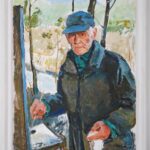
Karatajus Vladas
Vladas Karatajus was born on July 28, 1925 in Vilkaviškis. In 1946, he entered the Art Institute and a few years later entered the Figural Composition and Portrait Studio led by Professor Vytautas Mackevičius. In 1952, he graduated from the institute and was invited to teach. In 1965, Vladas Karatajus was awarded the title of associate professor, later he became a professor, and since 1968, he has headed the Department of Painting. Vladas Karatajus has held over 20 personal and group exhibitions in Lithuania and 3 joint exhibitions in foreign countries.
Paintings
The creative path of Vladas Karatajus is alien to the pursuit of showiness, fashion and innovations, superficiality and formality. The artist was well aware of the importance of searches and discoveries, experiments, and he tried more and more persistently to penetrate reality, to understand its essence and to express its depths with the most suggestive means of painting. Vladas Karatajus studied the work of classical art and Lithuanian painting masters, drew from their wisdom, followed the changes in artistic life, analyzed them and compared them with his own creative experience, thus laying the foundations for a unique creative path. He received his first art lessons from Petras Tarabilda, Ignas Piščikas, while studying from Vytautas Mackevičius he adopted compositional thinking and a clear structure of the painting, from Antanas Gudaitis – the principles of colorism, based on plein air, valor and decorativeness, and the traditions of Lithuanian portraiture – from Justinas Vienožinskis, Vladas Didžiokas, and studied from Algirdas Petrulis.
Vladas Karatajus was interested in the canvases of Vincent Van Gogh, Henri Matisse, Paul Cezanne, and drew creative inspiration from painting plein airs in Yugoslavia (1977) and Central Asia (1983). Vladas Karatajus is a colorist who believes in the limitless possibilities of color. A subtle sense of color, the ability to use its expressiveness and decorative possibilities in portraits, landscapes, and still lifes, combined with a subtle sense of compositional harmony and the structure of the picture. Portraiture, naturalness, coloristics, and compositional harmony are the four main categories that characterize the artist’s work. Painting itself is important in the artist’s work – a constant striving for the highest possible professionalism, an insistent need to reveal the secrets of painting.
Vladas Karatajus is a representative of the Lithuanian school of painting with deep historical roots, developing the traditions of realistic portraiture. It is the portrait genre, which revealed the boundless possibilities of cognition of reality, that uniquely marked the entire path of the artist’s creativity. Nature and its beauty are one of the main sources of inspiration and creative renewal for the artist, an object of attraction, therefore landscapes and still lifes occupy an important place in the work of Vladas Karatajus. The principles of realism are applied in them, but the pursuit of nature never led the artist to pure naturalism. Many of V. Karatajus’ landscapes and still lifes are not alien to the impressionistic perception of the world, the fixation of a moment. The artist’s landscape is close in concept to the portrait: for each object, the artist seeks an individualized characteristic, creating a unique image of a house, city or street. Vladas Karatajus is always faithful to nature, man and himself. Over more than five decades of creativity, the artist has not lost interest in the inexhaustible inner world of man and the boundless possibilities of artistic cognition. He is one of the most famous Lithuanian painters of the 20th century, who sought the meaning of his work in the genres of portrait, landscape and still life.
He died on April 19, 2014 in Vilnius.


